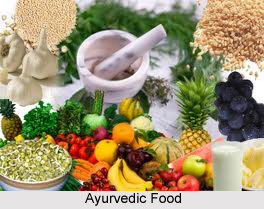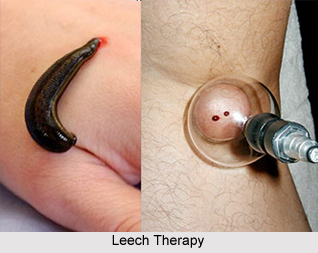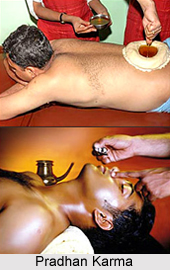 Pancha Karma is a specialised procedure of Ayurvedic treatment necessary for removing toxins and giving a healthy status to the body. It cleanses the body as well as improves digestion and metabolism. Purva karma (preparatory procedures), pradhan karma (five important procedures) and paschat karma (follow up treatments) are the three steps of panchakarma. Pradhan karma comes after purva karma and constitutes the five procedures of Vaman (Induced vomiting), Virechan (Induced purgation), Basti (Medicated enema), Nasya (Nasal medicine) and Rakta Mokshan (Artificial bloodletting).
Pancha Karma is a specialised procedure of Ayurvedic treatment necessary for removing toxins and giving a healthy status to the body. It cleanses the body as well as improves digestion and metabolism. Purva karma (preparatory procedures), pradhan karma (five important procedures) and paschat karma (follow up treatments) are the three steps of panchakarma. Pradhan karma comes after purva karma and constitutes the five procedures of Vaman (Induced vomiting), Virechan (Induced purgation), Basti (Medicated enema), Nasya (Nasal medicine) and Rakta Mokshan (Artificial bloodletting).
Vaman is a part of pradhan karma that is used for proper cleansing of the respiratory tract in case of respiratory disorders like recurrence of chronic cough, common cold, asthmatic bronchitis and bronchial asthma. Vaman also yields productive results in case of digestive disturbances like acidity, indigestion and jaundice. This method also helps in driving out the deposited kapha from the respiratory tract and the pitta accumulated in the digestive tract. Vaman also helps in eliminating pent up thoughts and tension from the mind. Psychological conditions like feeling of saturation, anxiety neurosis, compulsive obsessive disorder, vague dizziness, disturbed sleep and nightmares. Sometimes people experience the feeling that they have hair or a pin-like object or glass or poison unknowingly during intake of food. Vaman helps in getting rid of such eerie feelings. Pre-procedure: One to three days before carrying out vaman, internal snehan (oral consumption of optimum amount of or pure ghee) and swedan (fomentation) is done. This stimulates nausea, which eventually brings about vaman. Procedure: Vaman is usually done early in the morning after faeces have been eliminated from the body. 3 to 4 glasses of decoction of licorice (yashtimadhu) or emetic nut (madan fal) or simple salt water are consumed orally. After this the tongue is rubbed which excites the vomiting center in the brain thereby bringing about vomiting. When the patient vomits, it is collected in a measuring pot. The vomited liquid mainly contains mucous from the respiratory tract and digestive juices like excess bile and other disturbing secretions that cause irritation in the stomach. Results: After efficient vaman the patient has an immediate feeling of relief and freshness. Blockage, suffocation, and dullness vanish and the channels of the body become clear. Lost appetite and energy are regained. After fasting for 8 to 10 hours the patient has to take a light and mild diet along with plenty of water or natural fluids like coconut water, lemon juice, rice water and water from boiled pulses to prevent the body from getting dehydrated. Contraindications: Vaman is in general a crude treatment and is not recommended during pregnancy or in case of impaired immunity. Furthermore, if a patient is suffering from hematemesis or hemoptysis then vaman is not advisable.
 Virechan comes second in the catalogue of pradhan karma procedures. In case of an excess of pitta, virechan helps in restoring the body to health. When pitta crosses its normal limits, it accumulates in the body tissues and clogs the body channels. This accumulated pitta is made watery, directed towards an exit passage and then purged out of the body by means of virechan. Virechan brings relief in skin problems like acne, allergic skin conditions, inflammatory skin conditions and dermatitis. It helps in solving prolems of the digestive passage such as indigestion, loss of appetite, lack of taste, fear of the entry of toxic substances through food, milk or water, constipation, digestive disturbance due to consumption of unhealthy food, acid peptic disease (early stage), nausea or vomiting without any specific reason, jaundice and the like. Virechan is also prescribed in case of chronic fever, enlargement of spleen or certain urinary problems. Certain Ayurvedic practitioners recommend virechan for mental stress and strains, burning eye syndrome, repeated eye inflammation, and other eye problems occurring due to extremes of temperature in summer. Virechan is believed to restore the vaat, pitta, kafa balance that in turn ensures physical and mental health. Purgatives range from mild to strong. Mild ones include potion from senna leaf, tea, 2 to 4 teaspoonfuls of clarified butter mixed with warm milk, raisins, grapes and mango juice. Prune, dandelion root, flax seed husk, and psyllium seed can be categorised as moderate purgatives. A few of the above- mentioned substances in high dose, triphala powder (myrobalan, beleric myrobalan and dried rind of amla fruit), castor oil and a few ayurvedic preparations like ichchabhedi, narach-rasa act as strong purgatives. It is the work of an Ayurvedic specialist to properly choose laxatives according to the need and body type of the individual as well as the seasonal conditions. Procedure: The patient goes through snehan and swedan in the early morning. A light and preferably insipid diet is given as lunch. After lunch, the patient needs to take considerable amount of rest. The patient should not eat food that aggravates the three doshas. He should drink plenty of water or natural fluids to avoid dehydration. In dinner too, the patient has to take very light food. Virechan is administered at bedtime and the results are observed the following morning. 3 to 4 loose motions are adequate for absolute cleansing. Contraindications: Virechan is inadvisable in case of impaired immunity, dehydration, heightened fever, severe diarrhea, gastritis and gastroenteritis, ulcerative colitis, haematemesis. Proper virechan makes the person feel light, fresh, confident and positive.
Virechan comes second in the catalogue of pradhan karma procedures. In case of an excess of pitta, virechan helps in restoring the body to health. When pitta crosses its normal limits, it accumulates in the body tissues and clogs the body channels. This accumulated pitta is made watery, directed towards an exit passage and then purged out of the body by means of virechan. Virechan brings relief in skin problems like acne, allergic skin conditions, inflammatory skin conditions and dermatitis. It helps in solving prolems of the digestive passage such as indigestion, loss of appetite, lack of taste, fear of the entry of toxic substances through food, milk or water, constipation, digestive disturbance due to consumption of unhealthy food, acid peptic disease (early stage), nausea or vomiting without any specific reason, jaundice and the like. Virechan is also prescribed in case of chronic fever, enlargement of spleen or certain urinary problems. Certain Ayurvedic practitioners recommend virechan for mental stress and strains, burning eye syndrome, repeated eye inflammation, and other eye problems occurring due to extremes of temperature in summer. Virechan is believed to restore the vaat, pitta, kafa balance that in turn ensures physical and mental health. Purgatives range from mild to strong. Mild ones include potion from senna leaf, tea, 2 to 4 teaspoonfuls of clarified butter mixed with warm milk, raisins, grapes and mango juice. Prune, dandelion root, flax seed husk, and psyllium seed can be categorised as moderate purgatives. A few of the above- mentioned substances in high dose, triphala powder (myrobalan, beleric myrobalan and dried rind of amla fruit), castor oil and a few ayurvedic preparations like ichchabhedi, narach-rasa act as strong purgatives. It is the work of an Ayurvedic specialist to properly choose laxatives according to the need and body type of the individual as well as the seasonal conditions. Procedure: The patient goes through snehan and swedan in the early morning. A light and preferably insipid diet is given as lunch. After lunch, the patient needs to take considerable amount of rest. The patient should not eat food that aggravates the three doshas. He should drink plenty of water or natural fluids to avoid dehydration. In dinner too, the patient has to take very light food. Virechan is administered at bedtime and the results are observed the following morning. 3 to 4 loose motions are adequate for absolute cleansing. Contraindications: Virechan is inadvisable in case of impaired immunity, dehydration, heightened fever, severe diarrhea, gastritis and gastroenteritis, ulcerative colitis, haematemesis. Proper virechan makes the person feel light, fresh, confident and positive.
Basti is another step of pradhan karma that implies introduction of liquefied substances like medicated oils and herbal potions through the anus, urinary passage or vaginal orifice (in women) in order to cleanse the lower part of the body (below umbilical part). The ama (toxins) accumulated in the lower part of the body is first made to reach the lower digestive tract, urinary tract or reproductive tract by purvakarmas like snehan or swedan and then driven out by the process of basti. Basti proves effective in all kinds of vata dosha disorders like rheumatic joint pains, musculo-skeletal disorders and chronic headaches triggered by nervous disorders and digestive disorders. Basti is capable of curing most of the digestive disorders like dry colon, dry rectum, constipation, distention of abdomen, flatulence, spastic colon, dryness of digestive tract, general disorders like senile debility, impaired immunity, body debility, muscular dystrophy and bed ridden conditions like paralysis. Basti also cleans and nourishes the urinary tract and the reproductive tract in men and women. There are 8 main types of basti, namely "Anuvasana basti (medicated oil enema), niruha-asthapana basti (herbal decoction enema), uttar basti (cleaning the urinary bladder by passing a catheter, cleaning the birth passage in women by giving a vaginal douche), matra basti (limited oil enema taken daily for 3 or 7 days), yoga basti (scheduled enema for 1 week), kala basti (scheduled enema for 15 days), karma basti (scheduled enema for 1 month) and finally bruhan basti (nutritional enema)". Nutritional enema is good for metabolic problems like obesity, diabetes, obstructions in lymph gland, ascitis, urinary problems and birth canal problems while oil enema is good for curing digestive disorders. Contraindications: Basti is not advisable in case of diarrheas, dysenteries, rectal bleeding, diabetes, severe anaemia, hypoproteinaemia, breathlessness, and tuberculosis as well as associated with any problem and raj-yakshma ( pulmonary tuberculosis). It is also contraindicated in infantile problems and senile decrepitation.
 Nasya is an important step of pradhan karma which refers to the introduction of drugs through the nose which is believed to be a direct passage to the brain and hence the mind. When one or more of the three doshas pile up in the head or brain or mind, nasya is advised, as the nose is the nearest possible outlet for the elimination of these toxic substances. Nasya yields good results in various health problems like different types of headaches, convulsions, sinus congestion and some ailments of the eyes and the ears. It frees the mind from tensions and turmoil. There are six different types of nasya. They are as follows. Pradhamana nasya: This procedure stresses on proper cleansing and the medication is accordingly applied through the nose. It effectively cures kapha disorders, which in turn cause a heavy feeling in the head or a congestion of nose or sinusitis. Convulsions or epileptic attacks, Parkinsonism, black outs, unconsciousness are also treated by pradhamana nasya. The patient has to smell dry powders (for instance, vacha or brahmi powder) or recommended nasal irritants. In some cases, these substances are forcefully driven into the nose with the help of a tube. Bruhan nasya: it stresses on nutritional value and is used to cure abnormalities in vata that cause chronic headaches, dryness of sinuses, inability to smell, and psychological hindrances like anxiety, fear of unknown things, feeling of emptiness and recurrence of pessimistic thoughts. Ghee, oil or milk medicated with shatawari, ashwagandha or similar herbs are used for this treatment. Shaman nasya: this is important for sedation or soothing and cures ailments due to pitta disorders that promote nasal discharges, headaches, heat related disorders, buzzing noise in the ears, recurrence of conjunctivitis and thinning of the hair. Treatment is done with herbal potions, mild tea and medicated oil. Navana nasya: this is often advised in case of vaat-pitta or kafa-pitta disorders. Patients are treated with decoctions enriched with oil. Marshya nasya: in this treatment ghee or oil is administered to cure a particular symtom that if left unattended may proliferate into a disease. Pratimarshya nasya: this process includes administration of ghee or oil daily to the mucosal lining of the nose with a thoroughly clean little finger. By purifying the dhatus, it helps in curing ailments like respiratory allergies as well as mental stress and strain. Smelling or administering juice extracts of flowers like jasmine, champak, mogra, rose and henna is considered mild nasya. Using materials like brahmi, ginger, garlic, onion, black pepper and the like is considered strong nasya.
Nasya is an important step of pradhan karma which refers to the introduction of drugs through the nose which is believed to be a direct passage to the brain and hence the mind. When one or more of the three doshas pile up in the head or brain or mind, nasya is advised, as the nose is the nearest possible outlet for the elimination of these toxic substances. Nasya yields good results in various health problems like different types of headaches, convulsions, sinus congestion and some ailments of the eyes and the ears. It frees the mind from tensions and turmoil. There are six different types of nasya. They are as follows. Pradhamana nasya: This procedure stresses on proper cleansing and the medication is accordingly applied through the nose. It effectively cures kapha disorders, which in turn cause a heavy feeling in the head or a congestion of nose or sinusitis. Convulsions or epileptic attacks, Parkinsonism, black outs, unconsciousness are also treated by pradhamana nasya. The patient has to smell dry powders (for instance, vacha or brahmi powder) or recommended nasal irritants. In some cases, these substances are forcefully driven into the nose with the help of a tube. Bruhan nasya: it stresses on nutritional value and is used to cure abnormalities in vata that cause chronic headaches, dryness of sinuses, inability to smell, and psychological hindrances like anxiety, fear of unknown things, feeling of emptiness and recurrence of pessimistic thoughts. Ghee, oil or milk medicated with shatawari, ashwagandha or similar herbs are used for this treatment. Shaman nasya: this is important for sedation or soothing and cures ailments due to pitta disorders that promote nasal discharges, headaches, heat related disorders, buzzing noise in the ears, recurrence of conjunctivitis and thinning of the hair. Treatment is done with herbal potions, mild tea and medicated oil. Navana nasya: this is often advised in case of vaat-pitta or kafa-pitta disorders. Patients are treated with decoctions enriched with oil. Marshya nasya: in this treatment ghee or oil is administered to cure a particular symtom that if left unattended may proliferate into a disease. Pratimarshya nasya: this process includes administration of ghee or oil daily to the mucosal lining of the nose with a thoroughly clean little finger. By purifying the dhatus, it helps in curing ailments like respiratory allergies as well as mental stress and strain. Smelling or administering juice extracts of flowers like jasmine, champak, mogra, rose and henna is considered mild nasya. Using materials like brahmi, ginger, garlic, onion, black pepper and the like is considered strong nasya.
Rakta-moksha or bloodletting, the last form of pradhan karma, is used for cleansing blood. Toxins absorbed in the blood and circulated throughout the body can cause repeated infections, hypertension and certain other blood related problems. This are driven out by raktamoksha, which has now become an outdated practice with the advancement of new technologies. However, Rakta-moksha is also advised in case of enlarged liver, spleen and gout and in cases of dog, snake, scorpion or gadfly bite. There are several methods of bloodletting. These include draining out some blood through a nearby vein, making parallel cuts on the skin or applying a tumbadi (a cupping instrument). Rakta-moksha is inadvisable in cases of tuberculosis, anemia, jaundice or general weakness. Elders above 70 years and children below 10 years or breast-feeding mothers should not go through this process.
Thus, the five procedures of pradhan karma help in completely cleansing the body and removing most of the ailmants. This process is most effective when preceded by purva karma and followed by paschat karma.





